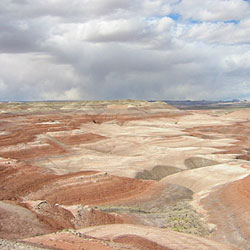
View of the desert in Utah. Image credit: Mars Desert Research Station. Click to enlarge.
Evidence of methane-producing organisms can be found in inhospitable soil environments much like those found on the surface of Mars, according to experiments undertaken by scientists and students from the Keck School of Medicine of USC and the University of Arkansas and published online in the journal Icarus.
The results, they said, provide ample impetus for similar “biodetection experiments” to be considered for future missions to Mars.
“Methane-producing organisms are the ones most likely to be found on Mars,” noted Joseph Miller, associate professor of cell and neurobiology in the Keck School and one of the study’s lead researchers. “And, in fact, methane was detected on Mars last year.”
Methane is considered to be a biological signature for certain living organisms that metabolize organic matter under conditions of low or no oxygen.
Terrestrial methanogens (methane-producers) are typically found in environments largely protected from atmospheric oxygen, such as peat bogs, oceanic methane ices and anoxic levels of the ocean. But they previously had not been detected in an arid desert environment.
To see if methane could be found in Mars-like soil, the investigators collected soil and vapor samples from the arid environment of the Mars Desert Research Station in Utah and then compared them with vapor samples taken from the Idaho High Desert and soil samples from Death Valley, the Arctic and the Atacama desert in Chile.
Three of five vapor samples from the Utah site showed the presence of methane; there was no methane found in any of the vapor samples from Idaho. Similarly, while five of 40 soil samples from Utah produced methane after the addition of growth medium to the samples – indicating that the methane was being given off by a biological organism, most likely a bacterium – none of the other soil samples showed signs of methane production.
Finding methane in the Utah desert is no guarantee that methane-producers exist on Mars, said Miller, who previously has analyzed data from the Viking Lander missions and found that soil samples taken in the 1970s from the Martian surface exhibited a circadian rhythm in what appeared to be nutrient metabolism, much like that present in terrestrial microbes.
However, Miller said, this recent experiment does provide “proof of principle [in that] it improves the case that such bacteria can and might exist on the Martian surface.” And, he added, that surely warrants further investigation during future missions to Mars.
In conclusion, the researchers wrote, “The detection of methane, apparently of biological origin, in terrestrial desert regolith bodes well for future biodetection experiments in at least partially analogous Martian environments.”
Original Source: USC News Release
